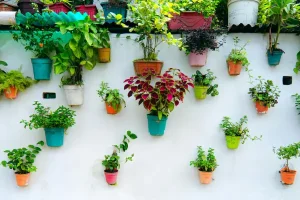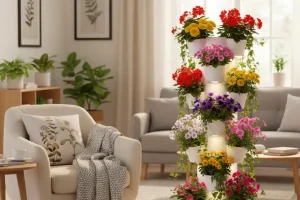Vertical flower gardens are beautiful, efficient, and space-saving—but like all gardens, they attract pests. Aphids, spider mites, caterpillars, and fungus gnats can quickly turn a thriving vertical display into a struggling mess if left unchecked.
The good news is that most flower pests are manageable with consistent monitoring and the right prevention techniques. This guide covers the most common pests in vertical beds, how to prevent infestations, and effective treatments that keep your flowers healthy without harming your garden ecosystem.
Why Pest Management Matters in Vertical Gardens
Vertical systems differ from traditional beds in a few important ways, and those differences change how pests behave. Tighter spacing means leaves, stems, and pockets sit close together, creating shaded nooks where aphids, mites, and whiteflies can multiply without you noticing.
Limited soil or media volume also means plants have fewer nutrients and less water to buffer stress; a small infestation can stunt growth fast. And because many vertical gardens share pumps, lines, or drip emitters, sap-sucking pests and fungal spores can spread from one pocket to the next in a hurry—what starts as a small problem on the top row can show up across the whole tower within days.
Catching issues early keeps plants vigorous, protects your investment in seeds and equipment, and preserves the look of your display all season. Make quick checks part of your watering routine: flip a few leaves, scan the top and bottom rows for sticky residue or webbing, and note any sudden leaf curl or yellowing.
Clean filters, keep airflow moving, and avoid overfeeding nitrogen, which pushes soft growth pests love. If you do spot trouble, isolate the affected module, prune heavily infested leaves, and treat promptly with gentle options like insecticidal soap, neem, or targeted biological controls.
A little attention now prevents big headaches later and keeps your vertical garden blooming and productive.save time, protect your investment, and keep blooms vibrant all season long.
Common Flower Pests in Vertical Beds
1. Aphids
- Small green, black, or white insects that cluster on new growth.
- Symptoms: curling leaves, sticky residue (honeydew).
- Prevention: Encourage ladybugs or lacewings, avoid over-fertilizing.
- Treatment: Spray with insecticidal soap or neem oil.
2. Spider Mites
- Tiny pests that thrive in hot, dry conditions.
- Symptoms: fine webbing, yellow speckling on leaves.
- Prevention: Maintain humidity and mist plants regularly.
- Treatment: Rinse leaves with water, apply neem oil or miticide if needed.
3. Whiteflies
- Small white insects that fly up when disturbed.
- Symptoms: yellowing leaves, stunted growth.
- Prevention: Use yellow sticky traps to monitor populations.
- Treatment: Apply insecticidal soap, repeat weekly until controlled.
4. Caterpillars
- Chew large holes in leaves and petals.
- Prevention: Inspect plants regularly, especially undersides of leaves.
- Treatment: Handpick or use Bacillus thuringiensis (Bt), a safe biological control.
5. Fungus Gnats
- Tiny black flies often found around damp soil.
- Symptoms: weak seedlings, yellowing plants from root damage.
- Prevention: Avoid overwatering, use well-draining soil.
- Treatment: Let soil dry between waterings, add sticky traps, or apply a biological control like beneficial nematodes.
Prevention Strategies for Healthy Vertical Gardens
- Regular Inspection: Check leaves (top and underside) weekly.
- Airflow: Don’t overcrowd plants—good airflow reduces pest risk.
- Balanced Fertilization: Too much nitrogen encourages pests like aphids.
- Sanitation: Remove dead leaves and spent blooms to eliminate hiding spots.
- Companion Planting: Add pest-repelling flowers like marigolds, nasturtiums, or lavender.
Quick Reference Table
| Pest | Symptoms | Prevention | Treatment |
| Aphids | Curling leaves, sticky residue | Encourage ladybugs | Neem oil, insecticidal soap |
| Spider mites | Fine webbing, yellow specks | Increase humidity | Water rinse, neem oil |
| Whiteflies | Flying white insects | Sticky traps | Insecticidal soap |
| Caterpillars | Chewed leaves/petals | Regular inspection | Handpick, Bt spray |
| Fungus gnats | Black flies near soil | Reduce watering | Dry soil, nematodes |
Common Mistakes to Avoid
- Ignoring early signs – By the time you see severe damage, infestations are harder to manage.
- Overusing chemical sprays – Can harm beneficial insects and create resistance.
- Neglecting system hygiene – Vertical systems spread pests faster if not cleaned regularly.
- Crowding plants – Dense foliage makes pest outbreaks worse.
FAQs
Q: Are natural treatments as effective as chemical pesticides?
Yes, for most small-scale gardens. Neem oil, insecticidal soaps, and biological controls are safer and effective.
Q: How often should I inspect my vertical garden?
At least once a week. Daily checks during hot, dry weather are even better.
Q: Can I prevent all pests?
No garden is 100% pest-free, but prevention and early treatment keep damage minimal.
Q: What flowers are naturally pest-resistant?
Marigolds, lavender, nasturtiums, and geraniums repel many common pests.
Next Steps & Related Reading
To boost your garden’s natural defenses, see Companion Planting: Flowers That Boost Vertical Vegetable Yields.
If you’re focused on maximizing beauty, explore How to Extend Bloom Time in Your Vertical Flower Tower.
Conclusion
Pests are a natural part of gardening, but with regular monitoring, smart prevention, and safe treatments, your vertical flower beds can remain healthy and vibrant. By combining good airflow, careful watering, and natural pest controls, you’ll protect your blooms without harsh chemicals.
Which pest has given you the most trouble in your vertical garden—aphids, spider mites, or fungus gnats?




